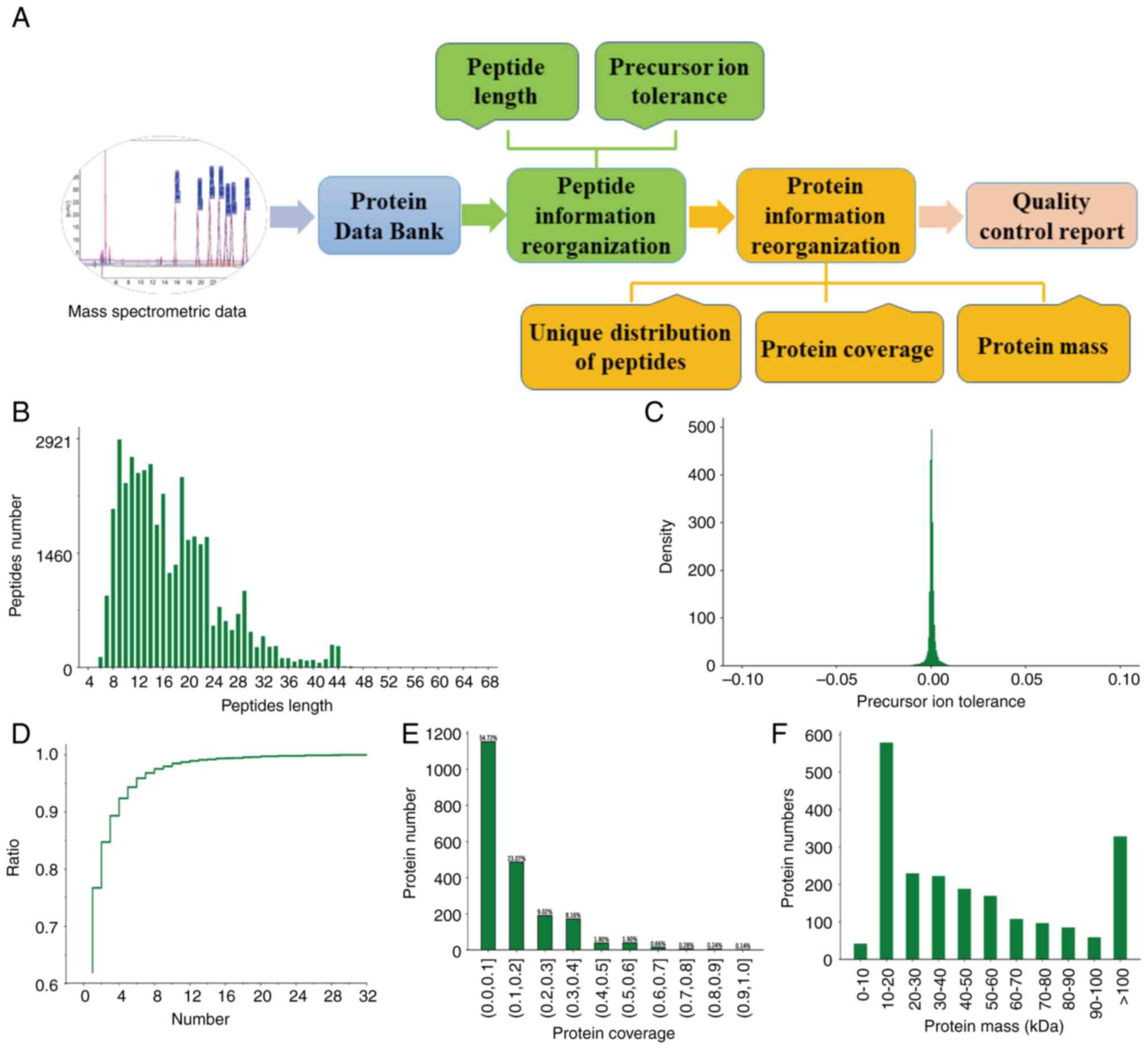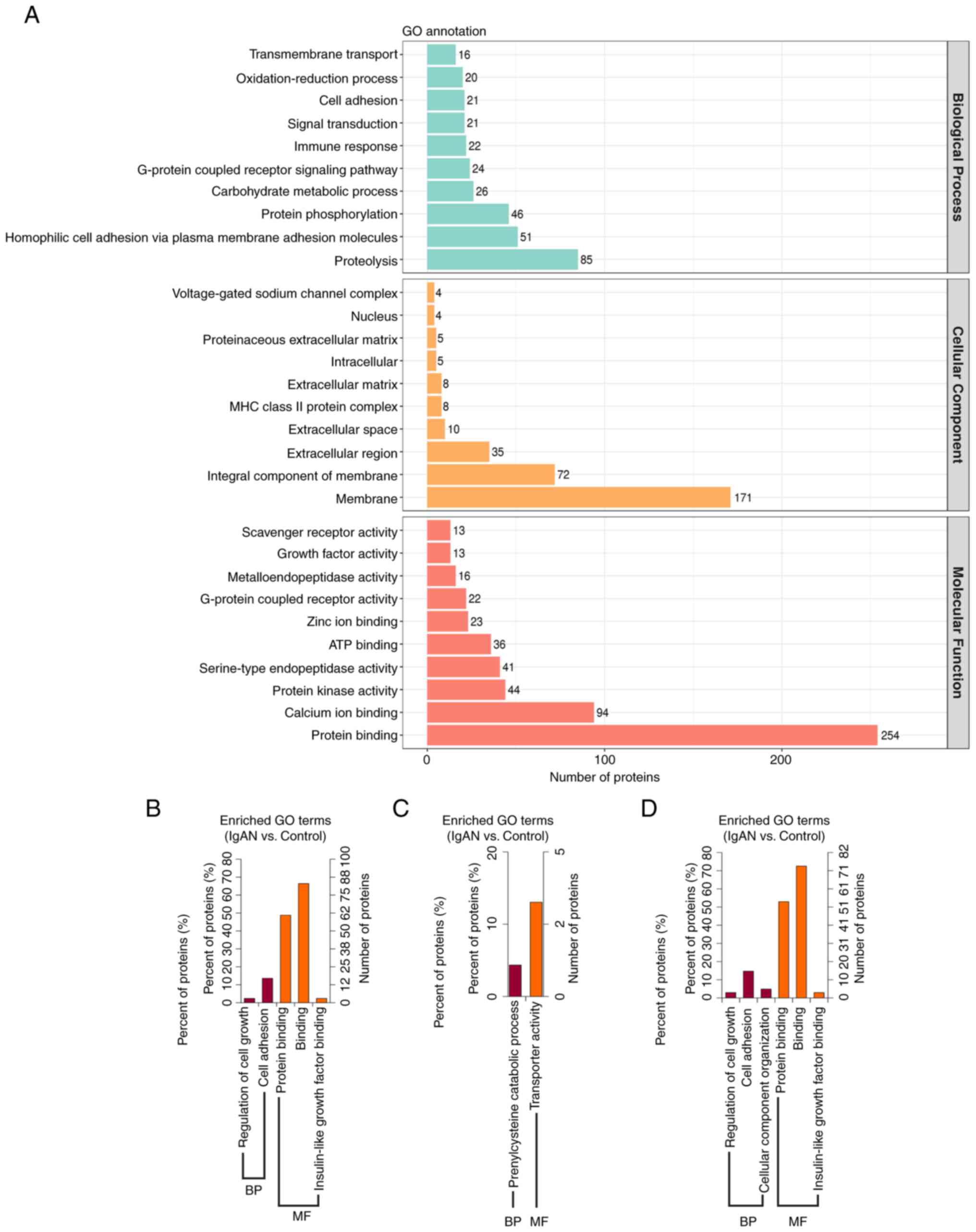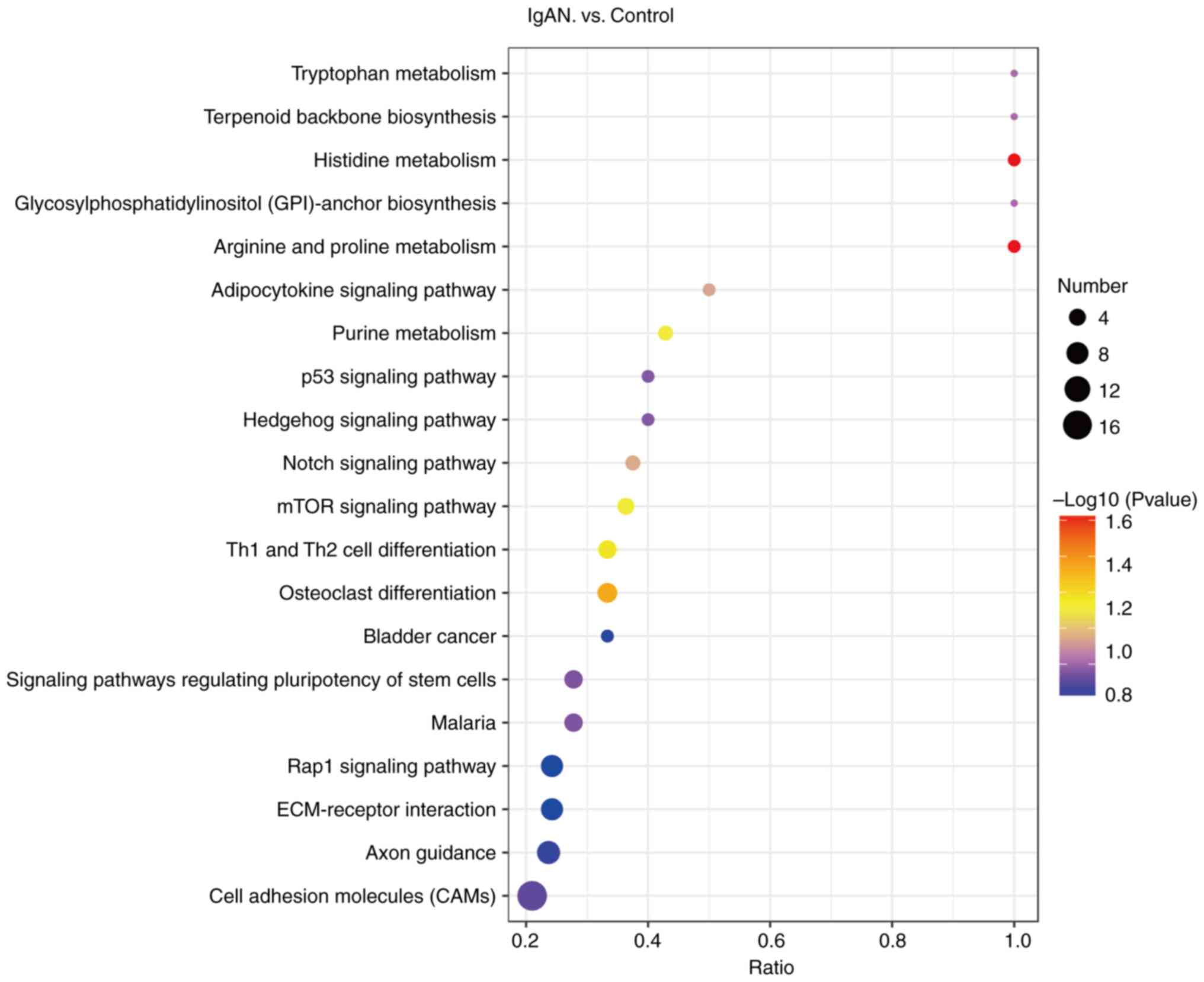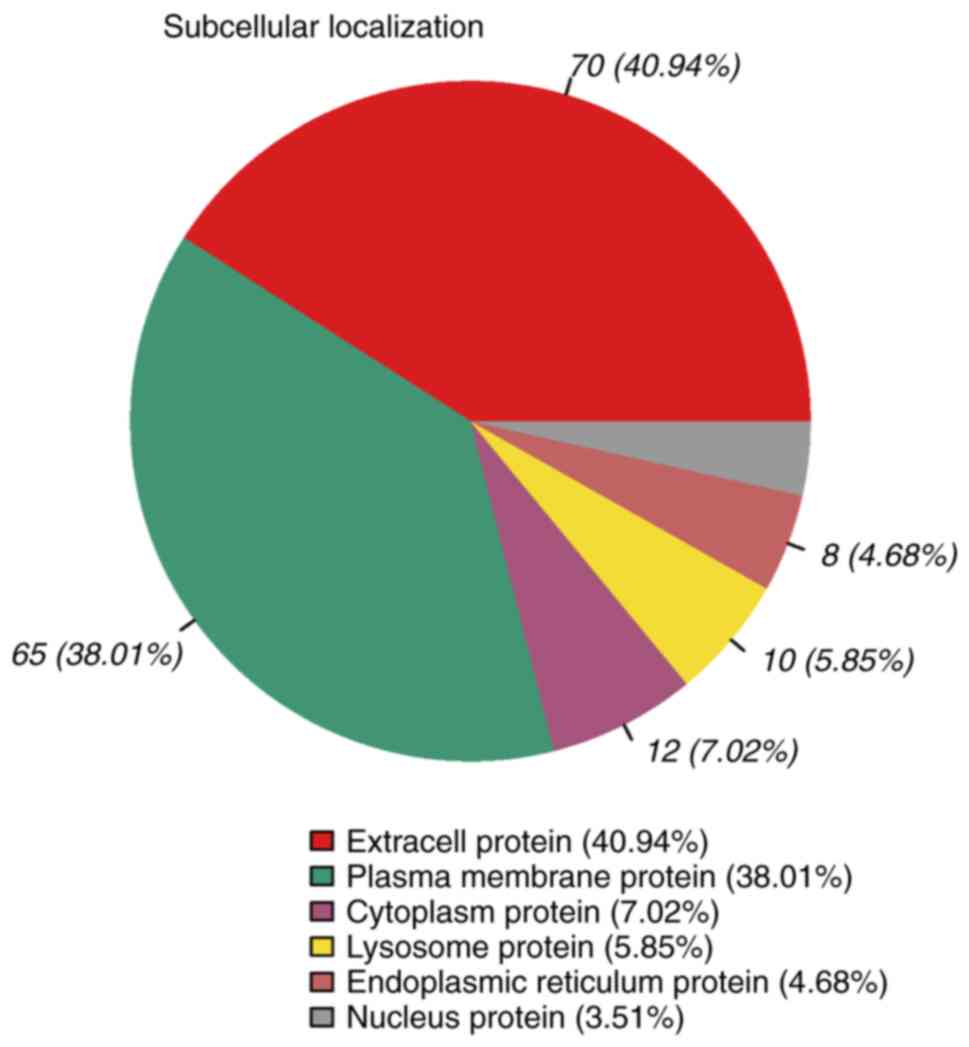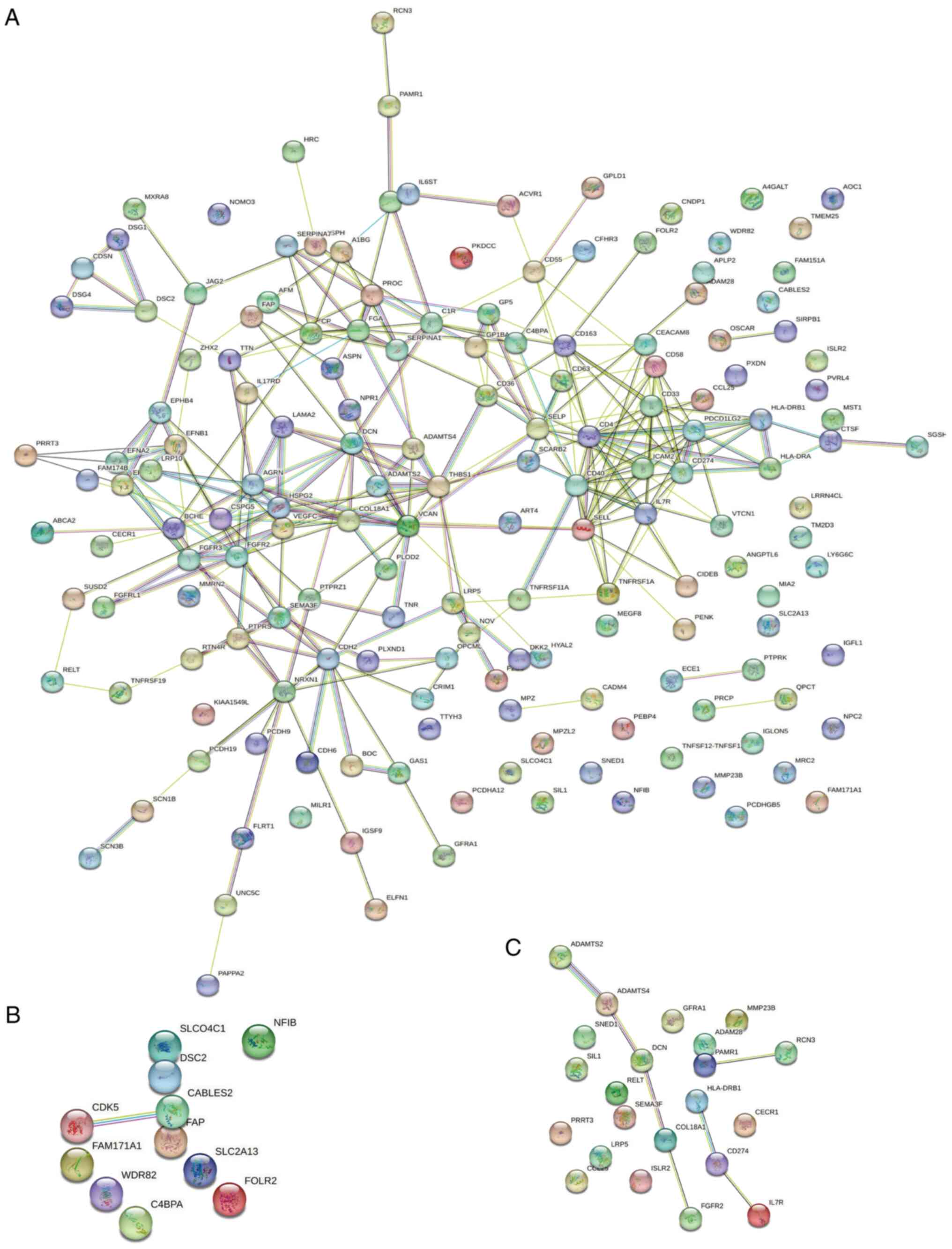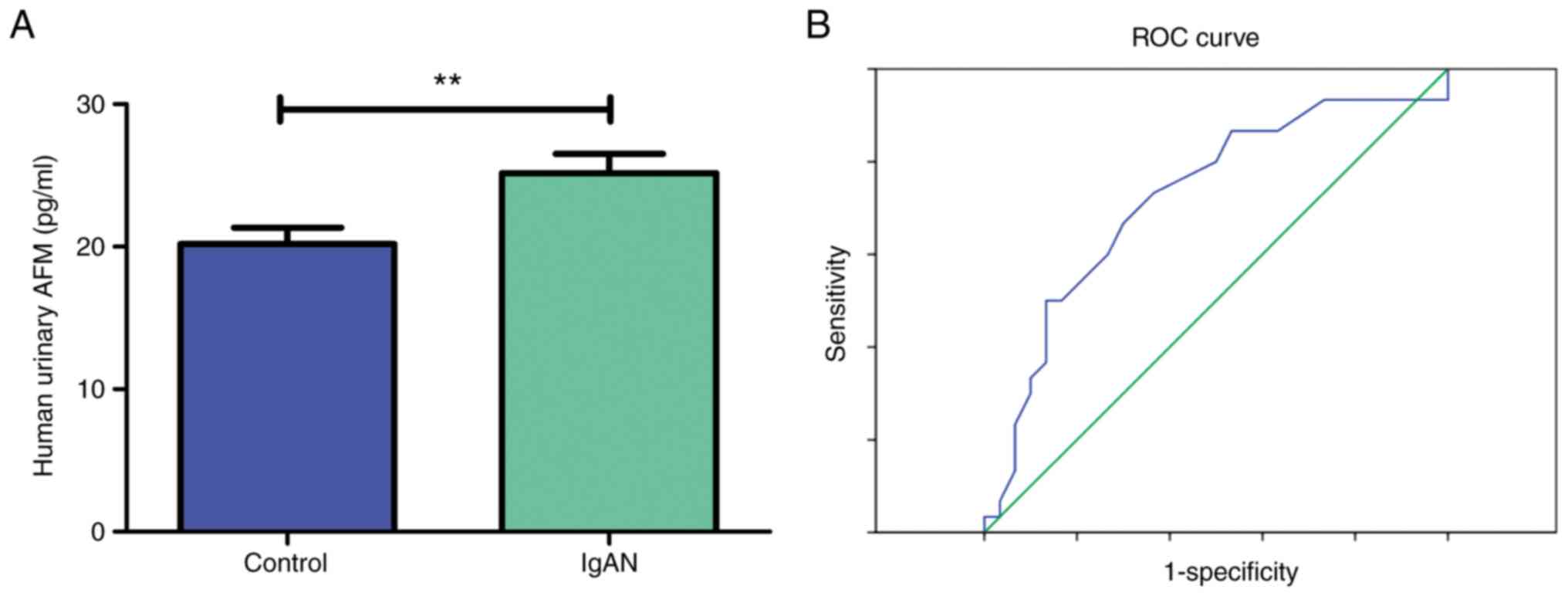|
1
|
Floege J, Rauen T and Tang SCW: Current
treatment of IgA nephropathy. Semin Immunopathol. 43:717–728.
2021.PubMed/NCBI View Article : Google Scholar
|
|
2
|
Nihei Y, Haniuda K, Higashiyama M, Asami
S, Iwasaki H, Fukao Y, Nakayama M, Suzuki H, Kikkawa M, Kazuno S,
et al: Identification of IgA autoantibodies targeting mesangial
cells redefines the pathogenesis of IgA nephropathy. Sci Adv.
9(eadd6734)2023.PubMed/NCBI View Article : Google Scholar
|
|
3
|
Yeo SC, Goh SM and Barratt J: Is
immunoglobulin A nephropathy different in different ethnic
populations? Nephrology (Carlton). 24:885–895. 2019.PubMed/NCBI View Article : Google Scholar
|
|
4
|
Hamano T, Imaizumi T, Hasegawa T, Fujii N,
Komaba H, Ando M, Nangaku M, Nitta K, Hirakata H, Isaka Y, et al:
Biopsy-proven CKD etiology and outcomes: The chronic kidney disease
Japan cohort (CKD-JAC) study. Nephrol Dial Transplant. 38:384–395.
2023.PubMed/NCBI View Article : Google Scholar
|
|
5
|
Liu Y, Wei W, Yu C, Xing L, Wang M, Liu R,
Ma J, Liu X, Xie R and Sui M: Epidemiology and risk factors for
progression in Chinese patients with IgA nephropathy. Med Clin
(Barc). 157:267–273. 2021.PubMed/NCBI View Article : Google Scholar : (In English,
Spanish).
|
|
6
|
Barratt J, Rovin B, Wong MG, Alpers CE,
Bieler S, He P, Inrig J, Komers R, Heerspink HJL, Mercer A, et al:
IgA nephropathy patient baseline characteristics in the sparsentan
PROTECT study. Kidney Int Rep. 8:1043–1056. 2023.PubMed/NCBI View Article : Google Scholar
|
|
7
|
Mohd R, Mohammad Kazmin NE, Abdul Cader R,
Abd Shukor N, Wong YP, Shah SA and Alfian N: Long term outcome of
immunoglobulin A (IgA) nephropathy: A single center experience.
PLoS One. 16(e0249592)2021.PubMed/NCBI View Article : Google Scholar
|
|
8
|
Pattrapornpisut P, Avila-Casado C and
Reich HN: IgA Nephropathy: Core curriculum 2021. Am J Kidney Dis.
78:429–441. 2021.PubMed/NCBI View Article : Google Scholar
|
|
9
|
Trimarchi H, Barratt J, Cattran DC, Cook
HT, Coppo R, Haas M, Liu ZH, Roberts IS, Yuzawa Y, Zhang H, et al:
Oxford classification of IgA nephropathy 2016: An update from the
IgA nephropathy classification working group. Kidney Int.
91:1014–1021. 2017.PubMed/NCBI View Article : Google Scholar
|
|
10
|
Chen T, Li X, Li Y, Xia E, Qin Y, Liang S,
Xu F, Liang D, Zeng C and Liu Z: Prediction and risk stratification
of kidney outcomes in IgA nephropathy. Am J Kidney Dis. 74:300–309.
2019.PubMed/NCBI View Article : Google Scholar
|
|
11
|
Gutiérrez E, Carvaca-Fontán F, Luzardo L,
Morales E, Alonso M and Praga M: A personalized update on IgA
nephropathy: A new vision and new future challenges. Nephron.
144:555–571. 2020.PubMed/NCBI View Article : Google Scholar
|
|
12
|
Bomback AS, Perazella MA and Choi MJ:
American society of nephrology quiz and questionnaire 2015:
Glomerular diseases. Clin J Am Soc Nephrol. 11:884–890.
2016.PubMed/NCBI View Article : Google Scholar
|
|
13
|
Koszegi S, Molnar A, Lenart L, Hodrea J,
Balogh DB, Lakat T, Szkibinszkij E, Hosszu A, Sparding N, Genovese
F, et al: RAAS inhibitors directly reduce diabetes-induced renal
fibrosis via growth factor inhibition. J Physiol. 597:193–209.
2019.PubMed/NCBI View
Article : Google Scholar
|
|
14
|
Wang S, Dong L, Qin A, Tan J, Zhou X and
Qin W: Roles of mesangial C3 and C1q deposition in the clinical
manifestations and prognosis of IgAN. Int Immunopharmacol.
120(110354)2023.PubMed/NCBI View Article : Google Scholar
|
|
15
|
Han X, Xiao Y, Tang Y, Zheng X, Anwar M
and Qin W: Clinical and pathological features of immunoglobulin A
nephropathy patients with nephrotic syndrome. Clin Exp Med.
19:479–486. 2019.PubMed/NCBI View Article : Google Scholar
|
|
16
|
Yu GZ, Guo L, Dong JF, Shi SF, Liu LJ,
Wang JW, Sui GL, Zhou XJ, Xing Y, Li HX, et al: Persistent
hematuria and kidney disease progression in IgA nephropathy: A
cohort study. Am J Kidney Dis. 76:90–99. 2020.PubMed/NCBI View Article : Google Scholar
|
|
17
|
Shen Y, Xiao T, Yu Z, Huang Y, He T, Li H,
Zhang J, Xiong J and Zhao J: Arteriolar hyalinosis and renal
outcomes in patients with immunoglobulin A nephropathy. Ren Fail.
44:994–1003. 2022.PubMed/NCBI View Article : Google Scholar
|
|
18
|
Ebbestad R, Sanaei Nurmi M and Lundberg S:
Long-term outcomes of patients with IgA nephropathy categorized by
the international IgAN Risk prediction tool and by the degree of
hematuria at diagnosis. Nephron. 146:573–583. 2022.PubMed/NCBI View Article : Google Scholar
|
|
19
|
Rauen T, Wied S, Fitzner C, Eitner F,
Sommerer C, Zeier M, Otte B, Panzer U, Budde K, Benck U, et al:
After ten years of follow-up, no difference between supportive care
plus immunosuppression and supportive care alone in IgA
nephropathy. Kidney Int. 98:1044–1052. 2020.PubMed/NCBI View Article : Google Scholar
|
|
20
|
Moriyama T, Tanaka K, Iwasaki C, Oshima Y,
Ochi A, Kataoka H, Itabashi M, Takei T, Uchida K and Nitta K:
Prognosis in IgA nephropathy: 30-Year analysis of 1,012 patients at
a single center in Japan. PLoS One. 9(e91756)2014.PubMed/NCBI View Article : Google Scholar
|
|
21
|
Cheung PW, Bouley R and Brown D: Targeting
the trafficking of kidney water channels for therapeutic benefit.
Annu Rev Pharmacol Toxicol. 60:175–194. 2020.PubMed/NCBI View Article : Google Scholar
|
|
22
|
Mihasan M, Wormwood KL, Sokolowska I, Roy
U, Woods AG and Darie CC: Mass spectrometry- and computational
structural biology-based investigation of proteins and peptides.
Adv Exp Med Biol. 1140:265–287. 2019.PubMed/NCBI View Article : Google Scholar
|
|
23
|
Goetze JP, Bruneau BG, Ramos HR, Ogawa T,
de Bold MK and de Bold AJ: Cardiac natriuretic peptides. Nat Rev
Cardiol. 17:698–717. 2020.PubMed/NCBI View Article : Google Scholar
|
|
24
|
Silsirivanit A: Glycosylation markers in
cancer. Adv Clin Chem. 89:189–213. 2019.PubMed/NCBI View Article : Google Scholar
|
|
25
|
Xu MM, Zhou MT, Li SW, Zhen XC and Yang S:
Glycoproteins as diagnostic and prognostic biomarkers for
neurodegenerative diseases: A glycoproteomic approach. J Neurosci
Res. 99:1308–1324. 2021.PubMed/NCBI View Article : Google Scholar
|
|
26
|
Connelly MA, Gruppen EG, Otvos JD and
Dullaart RPF: Inflammatory glycoproteins in cardiometabolic
disorders, autoimmune diseases and cancer. Clin Chim Acta.
459:177–186. 2016.PubMed/NCBI View Article : Google Scholar
|
|
27
|
Prikryl P, Vojtova L, Maixnerova D,
Vokurka M, Neprasova M, Zima T and Tesar V: Proteomic approach for
identification of IgA nephropathy-related biomarkers in urine.
Physiol Res. 66:621–632. 2017.PubMed/NCBI View Article : Google Scholar
|
|
28
|
Zeng W, Zheng S, Su T, Cheng J, Mao Y,
Zhong Y, Liu Y, Chen J, Zhao W, Lin T, et al: Comparative
N-glycoproteomics analysis of clinical samples via different mass
spectrometry dissociation methods. Front Chem.
10(839470)2022.PubMed/NCBI View Article : Google Scholar
|
|
29
|
Fang X, Lu M, Xia Z, Gao C, Cao Y, Wang R,
Wang M and Wu H: Use of liquid chromatography-tandem mass
spectrometry to perform urinary proteomic analysis of children with
IgA nephropathy and Henoch-Schönlein purpura nephritis. J
Proteomics. 230(103979)2021.PubMed/NCBI View Article : Google Scholar
|
|
30
|
Kawakita C, Mise K, Onishi Y, Sugiyama H,
Yoshida M, Yamada M and Wada J: Novel urinary glycan profiling by
lectin array serves as the biomarkers for predicting renal
prognosis in patients with IgA nephropathy. Sci Rep.
11(3394)2021.PubMed/NCBI View Article : Google Scholar
|
|
31
|
Ren W, Bian Q and Cai Y: Mass
spectrometry-based N-glycosylation analysis in kidney disease.
Front Mol Biosci. 9(976298)2022.PubMed/NCBI View Article : Google Scholar
|
|
32
|
Floege J, Wied S and Rauen T: Assessing
prognosis in IgA nephropathy. Kidney Int. 102:22–24.
2022.PubMed/NCBI View Article : Google Scholar
|
|
33
|
Choi YW, Kim YG, Song MY, Moon JY, Jeong
KH, Lee TW, Ihm CG, Park KS and Lee SH: Potential urine proteomics
biomarkers for primary nephrotic syndrome. Clin Proteomics.
14(18)2017.PubMed/NCBI View Article : Google Scholar
|
|
34
|
Lin Y, Yin P, Zhu Z, Peng Y, Li M, Li J,
Liang L and Yu X: Epigenome-wide association study and network
analysis for IgA nephropathy from CD19+ B-cell in
Chinese population. Epigenetics. 16:1283–1294. 2021.PubMed/NCBI View Article : Google Scholar
|
|
35
|
Buren M, Yamashita M, Suzuki Y, Tomino Y
and Emancipator SN: Altered expression of lymphocyte homing
chemokines in the pathogenesis of IgA nephropathy. Contrib Nephrol.
157:50–55. 2007.PubMed/NCBI View Article : Google Scholar
|
|
36
|
Grywalska E, Smarz-Widelska I,
Krasowska-Zajac E, Korona-Glowniak I, Zaluska-Patel K, Mielnik M,
Podgajna M, Malm A, Rolinski J and Zaluska W: The PD-1/PD-L1
inhibitory pathway is altered in primary glomerulonephritides. Arch
Immunol Ther Exp (Warsz). 66:133–143. 2018.PubMed/NCBI View Article : Google Scholar
|
|
37
|
Kaga H, Matsumura H, Suzuki T, Dohmae N,
Odaka M, Komatsuda A, Takahashi N and Wakui H: Comparative
proteomic analysis of glomerular proteins in primary and
bucillamine-induced membranous nephropathy. Clin Proteomics.
19(26)2022.PubMed/NCBI View Article : Google Scholar
|
|
38
|
Zhang Y, Hu R, Wu H, Jiang W, Sun Y, Wang
Y, Song Y, Jin T, Zhang H, Mao X, et al: OTUB1 overexpression in
mesangial cells is a novel regulator in the pathogenesis of
glomerulonephritis through the decrease of DCN level. PLoS One.
7(e29654)2012.PubMed/NCBI View Article : Google Scholar
|
|
39
|
In JW, Jung K, Shin S, Park KU, Lee H and
Song EY: Association of HLA-DRB1 and -DQB1 alleles with
susceptibility to IgA nephropathy in Korean patients. Ann Lab Med.
42:54–62. 2022.PubMed/NCBI View Article : Google Scholar
|
|
40
|
Jiyun Y, Guisen L, Li Z, Yi S, Jicheng L,
Fang L, Xiaoqi L, Shi M, Cheng J, Ying L, et al: The genetic
variants at the HLA-DRB1 gene are associated with primary IgA
nephropathy in Han Chinese. BMC Med Genet. 13(33)2012.PubMed/NCBI View Article : Google Scholar
|
|
41
|
Zhan X, Deng F, Wang AY, Chen Q, Du Y,
Wang Q, Zhong X, Zhang P, Wang W, Chen S, et al: HLA-DQB1 and
HLA-DRB1 expression is associated with disease severity in IgAN.
Ann Palliat Med. 10:9453–9466. 2021.PubMed/NCBI View Article : Google Scholar
|
|
42
|
López-Mejías R, Genre F, Pérez BS,
Castañeda S, Ortego-Centeno N, Llorca J, Ubilla B, Remuzgo-Martínez
S, Mijares V, Pina T, et al: Association of HLA-B*41:02 with
Henoch-Schönlein Purpura (IgA Vasculitis) in Spanish individuals
irrespective of the HLA-DRB1 status. Arthritis Res Ther.
17(102)2015.PubMed/NCBI View Article : Google Scholar
|
|
43
|
McCarlie VW, Hartsfield JK Jr, Blum JS,
González-Cabezas C, Chin JR, Eckert GJ, Morford LA, Pescovitz MD,
Rodriguez H, Fontana M and Gregory RL: Total IgA and IgA reactivity
to antigen I/II epitopes in HLA-DRB1*04 positive subjects. Open J
Immunol. 3:82–92. 2013.PubMed/NCBI View Article : Google Scholar
|
|
44
|
Li M, Wang L, Shi DC, Foo JN, Zhong Z,
Khor CC, Lanzani C, Citterio L, Salvi E, Yin PR, et al: Genome-wide
meta-analysis identifies three novel susceptibility loci and
reveals ethnic heterogeneity of genetic susceptibility for IgA
nephropathy. J Am Soc Nephrol. 31:2949–2963. 2020.PubMed/NCBI View Article : Google Scholar
|
|
45
|
Cao HX, Li M, Nie J, Wang W, Zhou SF and
Yu XQ: Human leukocyte antigen DRB1 alleles predict risk and
disease progression of immunoglobulin A nephropathy in Han Chinese.
Am J Nephrol. 28:684–691. 2008.PubMed/NCBI View Article : Google Scholar
|
|
46
|
Kiryluk K, Li Y, Sanna-Cherchi S,
Rohanizadegan M, Suzuki H, Eitner F, Snyder HJ, Choi M, Hou P,
Scolari F, et al: Geographic differences in genetic susceptibility
to IgA nephropathy: GWAS replication study and geospatial risk
analysis. PLoS Genet. 8(e1002765)2012.PubMed/NCBI View Article : Google Scholar
|
|
47
|
Li PK, Burns AP, So AK, Pusey CD, Feehally
J and Rees AJ: The DQw7 allele at the HLA-DQB locus is associated
with susceptibility to IgA nephropathy in Caucasians. Kidney Int.
39:961–965. 1991.PubMed/NCBI View Article : Google Scholar
|
|
48
|
Hahn WH, Suh JS, Park HJ and Cho BS:
Interleukin 7 receptor gene polymorphisms and haplotypes are
associated with susceptibility to IgA nephropathy in Korean
children. Exp Ther Med. 2:1121–1126. 2011.PubMed/NCBI View Article : Google Scholar
|
|
49
|
Moon PG, Lee JE, You S, Kim TK, Cho JH,
Kim IS, Kwon TH, Kim CD, Park SH, Hwang D, et al: Proteomic
analysis of urinary exosomes from patients of early IgA nephropathy
and thin basement membrane nephropathy. Proteomics. 11:2459–2475.
2011.PubMed/NCBI View Article : Google Scholar
|
|
50
|
Narimatsu H and Sato T: Wisteria
floribunda agglutinin positive glycobiomarkers: A unique lectin as
a serum biomarker probe in various diseases. Expert Rev Proteomics.
15:183–190. 2018.PubMed/NCBI View Article : Google Scholar
|
|
51
|
Gudehithlu KP, Hart P, Joshi A,
Garcia-Gomez I, Cimbaluk DJ, Dunea G, Arruda JAL and Singh AK:
Urine exosomal ceruloplasmin: A potential early biomarker of
underlying kidney disease. Clin Exp Nephrol. 23:1013–1021.
2019.PubMed/NCBI View Article : Google Scholar
|
|
52
|
Pang L, Duan N, Xu D, Jiao L, Huang C, Du
J, Guo Q and Li H: Urine afamin and afamin-creatinine ratio as
biomarkers for kidney injury. Biomark Med. 12:1241–1249.
2018.PubMed/NCBI View Article : Google Scholar
|
|
53
|
Kalantari S, Rutishauser D, Samavat S,
Nafar M, Mahmudieh L, Rezaei-Tavirani M and Zubarev RA: Urinary
prognostic biomarkers and classification of IgA nephropathy by high
resolution mass spectrometry coupled with liquid chromatography.
PLoS One. 8(e80830)2013.PubMed/NCBI View Article : Google Scholar
|
|
54
|
Berger J and Hinglais N: Intercapillary
deposits of IgA-IgG. J Urol Nephrol (Paris). 74:694–695.
1968.PubMed/NCBI(In French).
|
|
55
|
Rajasekaran A, Julian BA and Rizk DV: IgA
nephropathy: An interesting autoimmune kidney disease. Am J Med
Sci. 361:176–194. 2021.PubMed/NCBI View Article : Google Scholar
|
|
56
|
Yamagata K, Iseki K, Nitta K, Imai H, Iino
Y, Matsuo S, Makino H and Hishida A: Chronic kidney disease
perspectives in Japan and the importance of urinalysis screening.
Clin Exp Nephrol. 12:1–8. 2008.PubMed/NCBI View Article : Google Scholar
|
|
57
|
Donadio JV and Grande JP: IgA nephropathy.
N Engl J Med. 347:738–748. 2002.PubMed/NCBI View Article : Google Scholar
|
|
58
|
Schena FP, Rossini M, Abbrescia DI and
Zaza G: The molecular mechanisms of inflammation and scarring in
the kidneys of immunoglobulin A nephropathy: Gene involvement in
the mechanisms of inflammation and scarring in kidney biopsy of
IgAN patients. Semin Immunopathol. 43:691–705. 2021.PubMed/NCBI View Article : Google Scholar
|
|
59
|
Tan J, Luo X, Yang J, Liu N, Jiang Z, Tang
Y and Qin W: Clinicopathological characteristics and risk factors
in elderly patients with biopsy-proven IgA nephropathy. Ren Fail.
44:1026–1036. 2022.PubMed/NCBI View Article : Google Scholar
|















